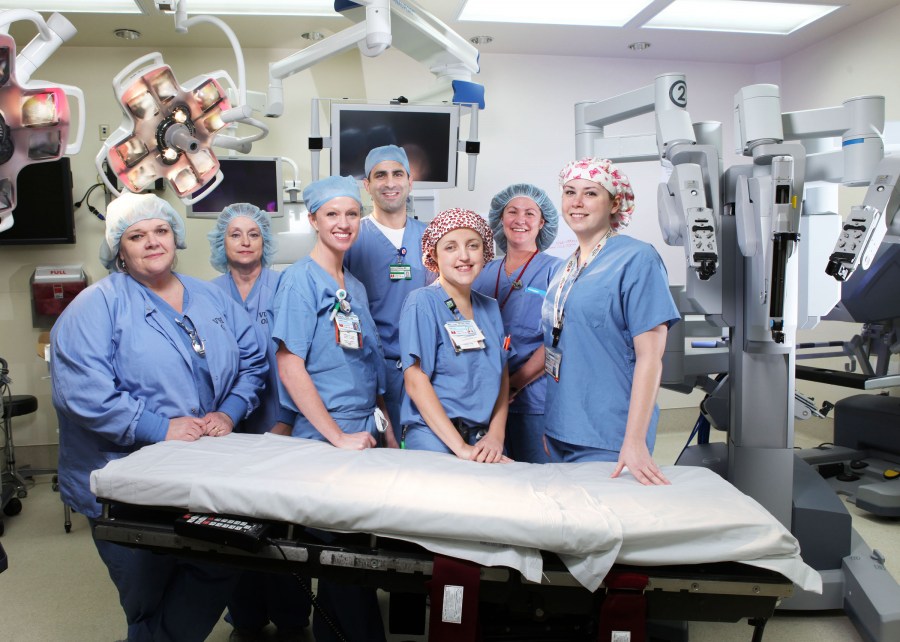
Pediatric Urology team members using the robotic surgery system include, from left, Shandra Sandgren, R.N., Carlene Beasley, L.P.N., Kristi Cook, R.N., John Thomas, M.D., Misty Jones, R.N., Vicki Bohannon, C.S.T., and Kim Seay, C.S.T. (photo by Susan Urmy)
Robotic device now available for pediatric surgeries
Surgeons at the Monroe Carell Jr. Children's Hospital at Vanderbilt have a new, cutting-edge robotic device for pediatric surgeries, joining an elite group of children's hospitals that employ the innovative tool.
On Wednesday, Feb. 23, a surgical team from the Division of Pediatric Urology fixed a kidney blockage (pyleoplasty) in an 8-year-old patient using the da Vinci Surgical System, a device designed to do complex surgeries with a minimally invasive approach. It was the inaugural surgery for the recently acquired device.
Last November, the team did what was believed to be Tennessee's first da Vinci surgery on a child, using Vanderbilt University Medical Center equipment routinely used for adult surgeries.
“We're taking procedures we do on a regular basis and applying a different technology to make them easier,” said John Thomas, M.D., assistant professor of Pediatric Urology. “The operation itself doesn't change, and we're still doing the surgery, but the device assists us. It's proven technology.”
The Surgical Division of Children's Hospital received the $1 million-plus da Vinci system, a third-generation model manufactured by Intuitive Surgical, in January.
The surgeon-controlled robot is expected to be used, at first, by the Division of Pediatric Urology. Shortly after, surgeons hope to apply the technology to general Pediatric Surgery.
The da Vinci unites conventional laparoscopy and traditional open surgery — at a more advanced level.
A surgeon sits at a console directing the tool's four arms, like a paintbrush on a canvas, to conduct delicate procedures with more precise movements. The robot also has a greater degree of freedom to maneuver, whereas laparoscopy is limited by the human hand's range of motion.
Potential patient benefits include minimal scarring and a shortened recovery period.
Rachel Miller, Tennessee's first child patient to have a da Vinci surgery, was thankful for a quick recovery. She had a dance audition for Nashville School for the Arts around the same time as her surgery to fix a blockage in her kidney.
“Rachel wants a career in dance, and the speedy recovery that the robot helped provide made it possible for her to follow her path,” said Rachel's mother, Tanna Miller. “She was dancing within three weeks of surgery. It was amazing.”
“We have a history with Vanderbilt, and we've developed quite a bit of trust over the years. Dr. Thomas's explanation about the surgery made good sense. We didn't have any concerns,” said Miller.
John W. Brock III, M.D., surgeon-in-chief for Children's Hospital, said the acquisition of the da Vinci for Children's Hospital was made possible by VUMC leadership.
“We are extremely excited to be able to offer this amazing technology to our children, which hopefully will not only improve their outcomes but also shorten their hospital stays and make us better at what we do from a surgical standpoint,” said Brock. “It is important to recognize that this cutting-edge technology is one of many that will be coming down our path over the next several years.”
Brock also recognized Thomas and his team, who received guidance and training from Vanderbilt's own robotics experts, such as Duke Herrell, M.D., director of Vanderbilt's Robotic Surgery Committee.
“The Children's Hospital robot acquisition will enable more minimally invasive procedures in children as well as stimulate innovation and procedural development, just as it has done in the adult hospital,” Herrell said.













